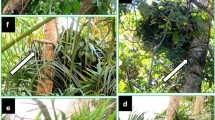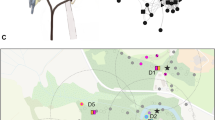Abstract
We report an empirical study on leaf-carrying, a newly discovered nest-building technique that involves collecting nest materials before reaching the nest site. We assessed whether leaf-carrying by rehabilitant orangutans on Kaja Island, Central Kalimantan, owes to cultural influences. Findings derive from ca 600 h observational data on nesting skills and nesting associations in Kaja’s 42 resident rehabilitants, which yielded 355 nests and 125 leaf-carrying cases by 34 rehabilitants. Regional contrasts with 14 other communities (7 rehabilitant, 7 wild) indicated cultural influences on leaf-carrying on Kaja. Association data showed exceptional social learning opportunities for leaf-carrying on Kaja, with residents taking differential advantage of these opportunities as a function of development, experience, and social position. Juvenile males with basic nesting skills were most influenced by social input. Most (27) leaf-carriers had probably learned leaf-carrying when caged and 7 probably learned it on Kaja. Social priming was probably the main impetus to leaf-carrying on Kaja, by simply prompting observers to copy when leaf-carrying associates collected nesting materials, what they collected, and where they used their collected materials. Implications concern acquisition processes and ontogenetic schedules that orchestrate sets of features—needs or interests, cognitive abilities, social preferences—which enable cultural transmission.


Similar content being viewed by others

References
Ancrenaz M, Calaque R, Lackman-Ancrenaz I (2004) Orangutan nesting behavior in disturbed forest in Sabah, Malaysia: Implications for nest census. Int J Primatol 25:983–1000
Anderson JR (2000) Sleep-related behavioural adaptations of free-ranging anthropoid primates. Sleep Med Rev 4:355– 373
Bernstein IS (1962) Response to nesting materials of wild born and captive born chimpanzees. Anim Behav 10:1–6
Bernstein IS (1967) Age and experience in chimpanzee nest building. Psychol Rep 20:1106
Biro D, Inoue-Nakamura N, Tonooka R, Yamakoshi G, Sousa C, Matsuzawa T (2003) Cultural innovation and transmission of tool use in wild chimpanzees: evidence from field experiments. Anim Cogn 6:213–223
Byrne RW (1994) The evolution of intelligence. In: Slater PJB, Halliday TR (eds) Behaviour and evolution. Cambridge University Press, Cambridge, UK, pp 223–264
Byrne RW (1999a) Cognition in great ape ecology: skill-learning ability opens up foraging opportunities. In: Box HO, Gibson KR (eds) Mammalian social learning: comparative and ecological perspectives. Cambridge University Press, Cambridge, UK, pp 333–350
Byrne RW, Russon AE (1998) Learning by imitation: a hierarchical approach. Brain Behav Sci 21:667–721
Coussi-Korbel S, Fragaszy D (1995) On the relation between social dynamics and social learning. Anim Behav 50:1441– 1453
Dewar G (2003) The cue reliability approach to social transmission: designing tests for adaptive traditions. In: Fragaszy D, Perry S (eds) The biology of traditions: models and evidence. Cambridge University Press, New York, pp 127–158
Fragaszy D, Perry S (eds) (2003a) The biology of traditions: models and evidence. Cambridge University Press, New York
Fragaszy D, Perry S (2003b) Towards a biology of traditions. In: Fragaszy D, Perry S (eds) The biology of traditions: models and evidence. Cambridge University Press, New York, pp 1– 32
Fruth B, Hohmann G (1996) Nest building behavior in the great apes: the great leap forward? In: McGrew WC, Marchant LF, Nishida T (eds) Great ape societies. Cambridge University Press, Cambridge, UK, pp 225–240
Galdikas BMF (1982) Orang-utan tool-use at Tanjung Puting Reserve, Central Indonesian Borneo (Kalimantan Tengah). J Hum Evol 10:19–33
Gibson KR (1993) Beyond neotony and recapitulation: New approaches to the evolution of cognitive development. In: Gibson KR, Ingold T (eds) Tools, language and cognition in human evolution. Cambridge University Press, Cambridge, UK, pp 251–269
Harrisson B (1960) A study of orang-utan behaviour in semi-wild state, 1956–1960. Sarawak Mus J 9:422–447
Harrisson B (1962) Orang-utan. Collins, London
Harrisson B (1963) Education to wild living of young orang-utans at Bako National Park, Sarawak. Sarawak Mus J 11:220– 258
Harrisson B (1969) The nesting behaviour of semi-wild juvenile Orang-utans. Sarawak Mus J 17:336–384
Horr DA (1977) Orang-utan maturation: growing up in a female world. In: Chevalier-Skolnikoff S, Poirier FE (eds) Primate bio-social development: biological, social, and ecological determinants. Garland, New York, pp 289–321
Huffman MA, Hirata S (2003) Biological and ecological foundations of primate behavioral traditions. In: Fragaszy D, Perry S (eds) The biology of traditions: models and evidence. Cambridge University Press, New York, pp 267–296
Inoue-Nakamura N, Matsuzawa T (1997) Development of stone tool use by wild chimpanzees (Pan troglodytes). J Comp Psychol 111:159–173
Knott CD (1998) Changes in orangutan caloric intake, energy balance, and ketones in response to fluctuating fruit availability. Int J Primatol 19:1061–1079
Laland K, Odling-Smee J, Feldman M (2000) Niche construction, biological evolution, and cultural change. Behav Brain Sci 23:131–146
Lefebvre L, Bouchard J (2003) Social learning about food in birds. In: Fragaszy D, Perry S (eds) The biology of traditions: models and evidence. Cambridge University Press, New York, pp 94–126
Lonsdorf EV, Eberly LE, Pusey AE (2004) Sex differences in learning in chimpanzees. Nature 428:715
Mabberley DJ (1997) The plant book: a portable dictionary of the vascular plants, 2nd edn. Cambridge University Press, Cambridge, UK
MacKinnon J (1974) The behaviour and ecology of wild orang-utans (Pongo pygmaeus). Anim Behav 22:3–74
Morrogh-Bernard H, Husson SJ, McLardy C (2002) Orang-utan data collection standardisation. http://www.orangutannetwork.net/data_collection.htm (retrieved April 2005)
Morrogh-Bernard H, Husson SJ, Page SE, O’Reiley JO (2003) Population status of the Bornean orang-utan (Pongo pygmaeus) in the Sebangau peat swamp forest, Central Kalimantan, Indonesia. Biol Conserv 110:141–152
Parker ST, McKinney M (1999) Origins of intelligence: the evolution of cognitive development in monkeys, apes, and humans. The Johns Hopkins Press, Baltimore, MD
Perry S, Baker M, Fedigan L, Gros-Louis J, Jack K, MacKinnon KC, Manson JH, Panger M, Pyle K, Rose L (2003) Social conventions in wild white-faced capuchin monkeys: Evidence for traditions in a neotropical primate. Current Anthropol 44:241–268
Peters H (1995) Orangutan reintroduction? development, use, and evaluation of a new method: reintroduction. Unpublished MSc Thesis, Groningen University, The Netherlands
Reader S, Laland K (eds) (2003) Animal innovation. Oxford University Press, Oxford
Rijksen HD (1978) A field study on sumatran orangutans (Pongo pygmaeus Abelii lesson 1827): Ecology, behaviour, and conservation. H Veenman and Zonen BV, Wageningen, The Netherlands
Russon AE (1998) The nature and evolution of orangutan intelligence. Primates 39:485–503
Russon AE (2002) Return of the native: cognition and site-specific expertise in orangutan rehabilitation. Int J Primatol 23:461–478
Russon AE (2003a) Innovation and creativity in forest-living rehabilitant orangutans. In: Reader S, Laland L (eds) Animal innovation. Oxford University Press, Oxford, pp 279–306
Russon AE (2003b) Developmental perspectives on great ape traditions. In: Fragaszy D, Perry S (eds) The biology of traditions: models and evidence. Cambridge University Press, New York, pp 329–364
Russon AE (2004) Great ape cognitive systems. In: Russon AE, Begun DR (eds) The evolution of thought: evolutionary origins of great ape intelligence. Cambridge University Press, Cambridge, UK, pp 76–100
Russon AE, Galdikas BMF (1995) Imitation and tool use in rehabilitant orangutans. In: Nadler RD, Galdikas B, Sheehan L, Rosen R (eds) The neglected ape. Plenum, New York, pp 191–197
Sidiyasa K (2001) Pulau Kaja dan vegetasinya: direncanakan sebagai “Midway House” Proyek Reintroduksi Orangutan Nyaru Menteng, Kalimantan Tengah. Departemen Kehutanan, Balai Litbang Kehutanan Kalimantan. [Kaja island and its vegetation: proposed as a “Midway House”, Orangutan Reintroduction Project at Nyaru Menteng, Central Kalimantan. Forestry Department, Kalimantan Forestry Research and Development Bureau, Kalimantan, Indonesia]
Sidiyasa K, Arifin Z, Abadi F (2001) Survei vegetasi di Pulau Kaja Kalimantan Tengah. Laporan Teknis Intern (tidak terbit). Balikpapan Orangutan Survival Foundation, Balikpapan, East Kalimantan, January 2001. [Vegetation survey of Kaja Island, Central Kalimantan. Internal Technical Report (unpublished)]
Singleton I, van Schaik CP (2001) Orangutan home range size and its determinants in a Sumatran swamp forest. Int J Primatol 22:877–911
Singleton I, Wich S, Husson S, Stephens S, Utami Atmoko S, Leighton M, Rosen N, Traylor-Holzer K, Lacy R, Byers O (eds) (2004) Orangutan population and habitat viability assessment: final report. IUCN/SSC Conservation Breeding Specialist Group, Apple Valley, MN
Smits WTM, Heriyanto, Ramono W (1994) A new method of rehabilitation of orangutans in Indonesia: A first overview. In: Ogden JJ, Perkins LA, Sheehan L (eds) Proceedings of the International Conference on “Orangutans: The Neglected Ape”. Zoological Society of San Diego, San Diego, CA, pp 29–40
Sugardjito J (1983) Selecting nest-sites of Sumatran orang-utans, Pongo pygmaeus abelii, in the Gunung Leuser National Park, Indonesia. Primates 24:467–474
Sugardjito J, te Boekhorst IJA, van Hooff J (1987) Ecological constraints on the grouping of wild orang-utans (Pongo pygmaeus) in the Gunung Leuser National Park, Sumatra, Indonesia. Int J Primatol 8:17–41
Swan RA, Warren KS (2000) Health, management, and disease factors affecting orang-utans in a reintroduction centre in Indonesia. Presented at The Apes: Challenges for the 21st Century. Chicago, pp. 10–13
Tuttle R (1986) Apes of the world. Noyes Publications, Park Ridge, NJ
Van Noordwijk MA, van Schaik CP (2005) Development of ecological competence by Sumatran orangutans. Am J Phys Anthropol 127:79–94
van Schaik CP (2004) Among orangutans: red apes and the rise of human culture. Belknap/Harvard University Press, Cambridge, MA.
van Schaik CP, Knott C (2001) Geographic variation in tool use in Neesia fruits in orangutans. Am J Phys Anthropol 114:331–342
van Schaik CP, van Hooff, J (1996) Toward an understanding of the orangutan’s social system. In: McGrew WC, Marchant LF, Nishida T (ed) Great ape societies. Cambridge University Press, Cambridge, UK, pp 3–15
van Schaik CP, Ancrenaz M, Borgen G, Galdikas B, Knott C, Singleton I, Suzuki A, Utami S, Merrill M (2003) Orangutan cultures and the evolution of material culture. Science 299:102–105
van Schaik CP, Deaner R, Merrill M (1999) The conditions for tool use in primates: implications for the evolution of material culture. J Hum Evol 36:719–741
van Schaik CP, Preuschoft S, Watts DP (2004) Great ape social systems. In: Russon AE, Begun DR (eds) The evolution of thought: evolutionary origins of great ape intelligence. Cambridge University Press, Cambridge, UK, pp 190–209
Whiten A, Goodall J, McGrew W, Nishida T, Reynolds V, Sugiyama Y, Tutin C, Wrangham R, Boesch C (1999) Cultures in chimpanzees. Nature 399:682–685
Wich SA, Utami-Atmoko SS, Mitra Setia T, Rijksen HD, Schürmann C, van Hooff J, van Schaik CP (2004) Life history of Sumatran orangutans (Pongo abelii). J Hum Evol 47:385–398
Acknowledgements
Studies of rehabilitant orangutans were authorized by Indonesia’s Institute of Sciences (LIPI) and sponsored by the Research Institute of the Indonesian Ministry of Forestry, Samarinda, E. Kalimantan, Indonesia, the TROPENBOS Foundation of the Netherlands, the BOS Foundation, and the Orangutan Reintroduction Projects at Wanariset and Nyaru Menteng. Glendon College and York University in Toronto, Canada, the Natural Sciences and Engineering Research Council of Canada, and the L.S.B. Leakey Foundation of the USA provided funding support for the research. The logistical support, archives, and staff assistance provided by the Orangutan Reintroduction Project at Nyaru Menteng were invaluable contributors to the Pulau Kaja study. Comparative facets of this study would not have been possible without input and comments by Marc Ancrenaz, Raffaella Commitante, Lone Droscher-Nielsen, Andrea Gibson, Simon Husson, Emilie Kissler, Cheryl Knott, Isabelle Lackman-Ancrenaz, Helen Morrogh-Bernard, Peter Pratje, Ian Singleton, Dhany Sitaparasti, Maria van Noordwijk, Carel van Schaik, Sri Suci Utami, and Serge Wich. We are grateful to four anonymous reviewers for comments on a previous draft of the paper. This study complies with the current laws of the country in which it was undertaken.
Author information
Authors and Affiliations
Corresponding author
Rights and permissions
About this article
Cite this article
Russon, A.E., Handayani, D.P., Kuncoro, P. et al. Orangutan leaf-carrying for nest-building: Toward unraveling cultural processes. Anim Cogn 10, 189–202 (2007). https://doi.org/10.1007/s10071-006-0058-z
Received:
Revised:
Accepted:
Published:
Issue Date:
DOI: https://doi.org/10.1007/s10071-006-0058-z



